Charterhouse Rheumatism Clinic
56-60 Weymouth Street, Marylebone, W1N 4DX
Medical dates:
Medical character:
Specialist
In 1928 the Charterhouse Mission in Southwark granted Dr Henry Warren Crowe (1875-1967) permission to use two rooms in its Girls' Club as a free clinic for patients with rheumatism (see list below) on four afternoons a week.
Dr Warren Crowe had founded the Charterhouse Rheumatism Clinic as an initial experiment to determine whether rheumatic disorders could be treated by a simple ambulatory method such as stock vaccine. The rationale of stock vaccine therapy was the supposition that low-grade streptococcal or staphylococcal infection played a large part in the causation of 'rheumatism'. Focal infection theory had become popular in the late 19th and early 20th centuries, with dental caries usually being blamed as the cause for systemic disease, either due to the spread of the infection itself or from the toxins produced by it. (During the 1920s this had resulted in an extremely high number of extracted teeth.)
Initially, about 20 patients a week were seen at the Clinic. They were treated free of charge upon a letter of recommendation from their G.P. No case, however crippled, who could be brought up the stairs, was refused.
Patients were treated by a weekly injection of stock vaccine (in varied and minute doses), which contained streptococci (considered to be the main cause of osteoarthritis and non-articular rheumatoid disease) or staphylococci (mainly considered responsible for rheumatoid arthritis), or the two mixed together, or streptococci mixed with pneumococci. The staphylococcal vaccine included three different varieties of proven importance in rheumatoid disease. If vaccine therapy proved to be possible and effective, G.P.s would be able in future to treat patients at their own surgeries or in the patients' homes.
As the number of patients increased at the Clinic, a need arose for facilities for special investigations of difficult cases, as well as office space for clerical work (records of patients' treatments were meticulously kept). In 1932 the Clinic opened a second branch at 94, Hallam Street, which had offices, an X-ray Department for special investigations, and a bacteriology laboratory with an adjuvant physiotherapy treatment room. To finance these new premises, a new class of patient was admitted, who paid a small inclusive fee for treatment (their eligibility was based on a referral letter from their G.P. and an income of less than £250 a year). This financial arrangement enabled the poor of Southwark to continue to receive free treatment, and also to be sent for special investigations at Hallam Street.
The Hallam Street branch was intended to be a temporary solution as the number of patients had increased by a hundredfold from the initial weekly clinics. The Clinic required larger premises with centralisation of its activities in research, treatment and education.
Treatments by now included wide field X-ray therapy (which was given not for the destruction of any disease, but for its tonic or stimulating effect on the body as a whole, and was intended to build up resistance of the body to disease) and chrysotherapy (gold treatment) if the patient was too sensitive to take vaccine. (The gold was used as an immunising agent, not as chemotherapy.)
During the 1930s clinics practising identical methods of treatment had been established in all parts of the United Kingdom, the United States, Canada, South Africa, Australia, India and New Zealand.
In 1936 the Charterhouse Rheumatism Clinic was place in the hands of a Charity Trust, whose Council regulated policy and was responsible for the finance of building the new premises. The Clinic was administered by a committee of six, three of whom were on the medical staff. The Director of the Clinic was the Senior Physician, who acted as the actual manager and appointed the medical staff. Appointments were for one year only and renewable every December.
In July 1938 the first issue of Rheumatism was published under the Editorship of Mr John Ryan, FRCS, with the purpose of providing a record of the meetings held at the Clinic. (The journal survived WW2 , but ceased publication in January 1967, not from financial pressures, but because it considered itself superfluous. It was also the year in which Dr Warren Crowe died.)
In 1939 both existing branches of the Clinic closed when it moved to its new building in Weymouth Street, which was officially opened on 29th March by the Duchess of Gloucester. The Clinic then closed for holidays from 19th August until 3rd September, just at the outbreak of WW2.
The 5-storey building, which had been established at a cost of £33,000 (including a gift of £5,000 from Lord Nuffield) had a 50 ft (15 metres) frontage on the north side of Weymouth Street. It centralised the clerical, investigative, research and treatment activities of the Clinic under one roof and meant that some 2,000 patients a week could be treated.
The ground floor contained offices for clerical and filing purposes, and two sets of consulting and examination rooms for patients of limited means. The basement housed a large department for free clinics and a physiotherapy room. The main waiting hall could also be used as a lecture room.
On the first floor were the main routine laboratories and the X-ray Department. The latter was used both for diagnostic purposes and for wide field radiation therapy (especially in the treatment of ankylosing spondylitis, a disease of young people presenting with bilateral sacroiliitis, followed eventually by spinal involvement).
The second and third floors contained beds for arthritic patients.
The top floor, under a flat roof, contained the laboratories producing bacterial media, and a series of biochemistry and bacterial research laboratories. Research was conducted into 'menopausal arthritis', the avoidance of toxic reactions during gold treatment, pain control, and into various methods of injecting joints in order to reduce inflammation and effusion (fluid).
Now three classes of patients were eligible for treatment - the hospital class (that is, nominally free), those who paid a small regular fee (all income tax payers) or whose standard fees were covered by Approved Societies, and those whose incomes were above this (in other words, private patients). The last were treated on the ground floor while the other two groups were seen in the basement.
Special investigations (X-ray examinations) and autogenous vaccines (those individually tailored for a patient) had to be paid for. The patient was asked what he could afford, for example, from 2s 6d to 10s 6d (£0.25 to £0.53) for plain X-rays, from 10s 6d to 3 guineas (£0.53 to £3.15) for a full investigation or, for example 5 shillings (£0.25) for manipulation.
In February 1942 a new branch of the Clinic was officially opened by Geoffrey Hutchinson, the M.P. for Ilford, at 207-209 Cranbrook Road in Gants Hill. It had been designed as a mini-Weymouth Street, with one small laboratory. Although it had no X-ray machine, the Physiotherapy Department contained shortwave and diathermy apparatus in a screened-off cubicle.
The Clinic did not join the NHS in 1948, but remained an independent healthcare facility.
By 1953 the Clinic had been reorganised. Although it was popularly believed to provide only vaccine therapy, it offered a spectrum of treatments. As well as the radiation and gold therapies, intra-articular injections of acid potassium phosphate were given for osteoarthritis, and painful muscles were infiltrated with procaine - also known as the anti-aging drug Gerovital H3 (GH3). In March 1955 the Duchess of Gloucester opened a new X-ray Department.
By the 1960s most London teaching hospitals had established their own Departments of Rheumatology for the study and treatment of rheumatic disorders. With the arrival of new drugs, vaccine therapy fell out of fashion, while joint replacement surgery for damaged joints proved increasingly effective and popular. Nevertheless, the aetiology of many rheumatic disorders remains obscure.
The Clinic closed in 1979.
The building now contains the Finance and Fund-Raising offices of the King Edward VII's Hospital Sister Agnes, with associated apartments above.

The site of the original Free Clinic at 39 Crosby Row, Long Lane, Southwark, is now the ARC Nursery.
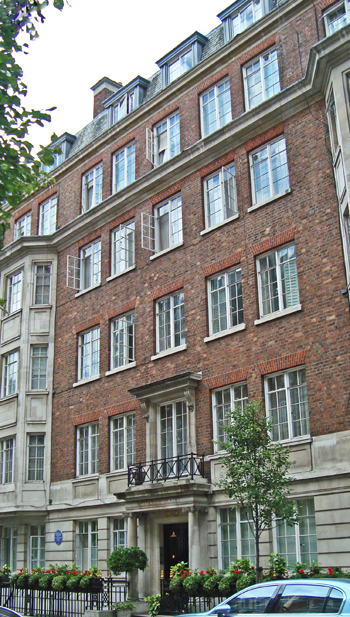
The second branch of the Clinic was at 94 Hallam Street.
Weymouth House, a residential mansion block, now occupies the site (above and below).
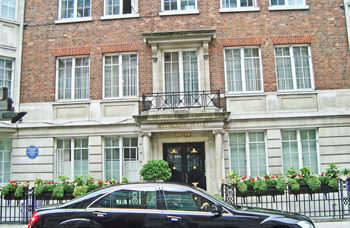
The main entrance to Weymouth House.
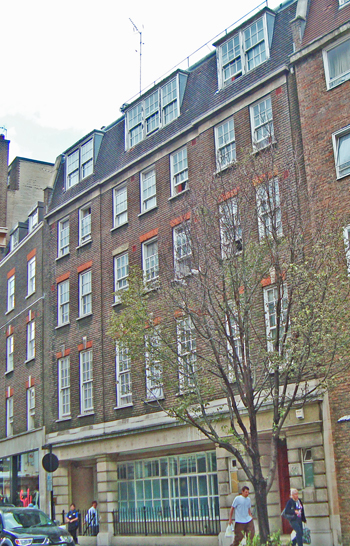
The final site of the Clinic was at 56-60 Weymouth Street, now part of the King Edward VII's Hospital Sister Agnes.
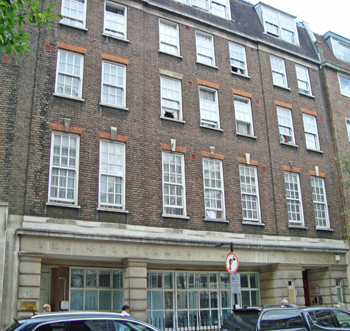
The position of the lettering 'The Charterhouse Rheumatism Clinic' can still be discerned on the stone fascia of the building.
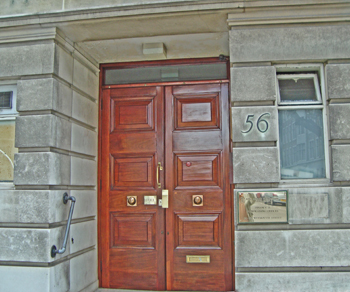
The main entrance at No. 56 to the right-hand side of the building; the left-hand door at No. 60 leads to the apartments.
Rheumatism
"Rheumatism" is an omnibus term which has little or no scientific meaning. It is usually used to describe joint pain until a correct diagnosis can be made.
"Rheumatism" is an omnibus term which has little or no scientific meaning. It is usually used to describe joint pain until a correct diagnosis can be made.
Conditions treated at the Clinic as listed by Dr Warren Crowe in 1939 |
|
Non-articular rheumatism (bones or joints not involved) |
|
Rheumatism near joints
(capsulitis, bursitis, synovitis, tenosynovitis)
|
|
Rheumatism in muscle (myositis, painful cramps, spasm) |
|
Rheumatism in fibrous tissue (fibrositis) |
| Rheumatism associated with superficial fatty tissue (panniculitis) |
|
Rheumatism exerting pressure on nerve roots, trunk and endings (neuralgia) |
|
Rheumatism involving nerve sheaths (neuritis) |
| Rheumatism involving bones and joints |
| Osteoarthritis |
| Infective arthritis |
| Rheumatoid arthritis |
|
Ankylosing spondylitis |
|
Mixed arthritis (rheumatoid arthritis and infective arthritis or osteoarthritis) |
| Gout |
(Author unstated) 1932 Medical news. British Medical Journal 2 (3751), 994.
(Author unstated) 1939 Medical news. British Medical Journal 1 (4081), 654.
Bywaters EGL 1988 Historical aspects of the aetiology of rheumatoid arthritis. Rheumatology 27 (Suppl. 2), 110-115.
Raikes KC, et al. 1953 Letter to the Editor: Charterhouse Rheumatism Clinic. Lancet 262 (6776), 91.
Ryan J 1938 History of the Charterhouse Clinic. Rheumatism 1, 29-31.
Warren Crowe H 1930 Correspondence: The Charterhouse Rheumatism Clinic. Lancet 216 (5598), 1318.
http://en.wikipedia.org
www.aim25.ac.uk
www.memoryprints.com
www.scienceandsociety.co.uk
www.wpafilmlibrary.com
Return to home page